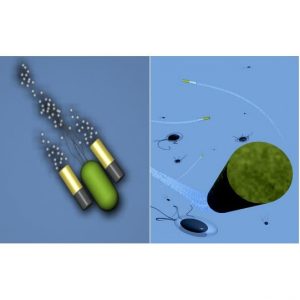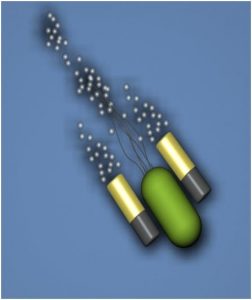 Welcome to one of our guest columns, where active researchers can share their views on topics relevant to materials science. Professor Geoffrey Ozin from the University of Toronto talks about the nanochemistry highlights of 2011. More articles from Professor Ozin can be found at nanochemistry.materialsviews.com.
Welcome to one of our guest columns, where active researchers can share their views on topics relevant to materials science. Professor Geoffrey Ozin from the University of Toronto talks about the nanochemistry highlights of 2011. More articles from Professor Ozin can be found at nanochemistry.materialsviews.com.
As we enter 2012, inspired and captivated by a myriad of exciting discoveries in the field of nanochemistry, with new world records for bottom-up synthesis of inorganic materials fashioned as the narrowest nanowires and thinnest nanosheets, largest nanopores and smallest nanogaps, biggest supracrystals and most extensive superlattices made of nanocrystals and nanorods, nanoplatelets and nanooctapods, it seemed like a good idea to look back at some influential 2011 papers with a common theme that by any measure would be considered ‘surprising’ by an experienced materials research community with respect to the high level of creative thinking, skillful inventiveness, extraordinary scientific impact and widespread technological implications.
In this vein I would contend that a potentially revolutionary new paradigm in nanochemistry is ‘nanolocomotion’ where the power source for the propulsion of a nanoscale object such as a rod, tube, sphere or sphere dimer, is drawn from a chemical reaction of an energy-rich fuel localized on a specific region of the nanoscale object.
A perquisite for this kind of chemically powered motion is the creation of an anisotropic force on a nanoscale object, which can be generated by constructing the object with an asymmetric structure, like a Janus sphere, a tapered nanotube or a bimetal segmented nanorod.
The work of the PennState groups of Tom Mallouk and Ayusman Sen and my University of Toronto group is notable in this respect who first demonstrated the use of hydrogen peroxide as a fuel to induce linear and rotary motion of asymmetric bimetal nanorods made of Pt-Au and Ni-Au in an aqueous environment. To create nanorod motion, forward thrust has to overcome viscous frictional forces and the power to achieve this was derived from the catalyzed decomposition of hydrogen peroxide 2H2O2 → 2H2O + O2 localized at the Ni or Pt ends of the nanorods.
The early challenge in this field was to establish a fundamental understanding of the physicochemical principles that underpin nanorod motion and with this knowledge devise ways to control the velocity, direction and trajectory of the nanorod, in order to be able to rationally design and build nanomachines that perform a useful task with acceptable speed, reliability and efficiency.
With this brief background on chemically powered nanomotors, in what follows I will highlight some spectacular advances recorded in 2011 that take this budding field of research to even greater heights.
In a significant departure from the ‘fixation on hydrogen peroxide’ as a fuel to generate locomotion of nanomotors, the group of Ayusman Sen described an innovative bimetal copper-platinum nanorod motor where thrust was generated through a self-electrophoresis mechanism induced by battery-type coupled redox reactions of an aqueous bromine solution localized at the ends of the nanorod.
The motion originates from anodic oxidative dissolution of the copper segment induced by the bromine which occurs concurrently with cathodic reduction of bromine or hypobromite at the platinum segment according to the short-circuited battery equations:
Cu → Cu2+ + 2e– Eo= 0.3419 V
Br2 + 2e– → 2Br– Eo = 1:0873 V
HBrO + H+ + 2e– → Br– + H2O Eo = 1:3310 V
The origin of the nanorod motion is explained in terms of electro-osmostic fluid-flow of a positive electrical double-layer of ions along a negative (metal-oxide-passivated) surface from the copper positive anode towards the platinum negative cathode ends of the bimetal nanorod. This occurs simultaneously with electron transport from the anode to the cathode, which in accord with the concept of ‘Galilean inverse’ causes the nanorod to translate in the opposite direction, led by the copper end.
While neither hydrogen peroxide nor bromine are environmentally friendly reagents, they are currently the only efficient transducers of stored chemical potential to mechanical energy; however for nanomotors to establish their usefulness in real world applications a challenge for future work is to discover alternative fuels that are environmentally benign and biocompatible.
Another innovative contribution from the group of Ayusman Sen that expands and enriches the scope of catalytic reactions for powering nanoscale motors, involves the development of thrust from the catalytic polymerization of an organic monomer localized on one side of a Janus microsphere. The basis of the motion is a ring-opening polymerization reaction of norbornene using a Grubb’s catalyst.
The principle of operation is based on a Grubb’s catalyst that is chemically tethered to the silica side of a gold-silica Janus microsphere. Because of the lower monomer concentration developed in the proximity of the silica polymerization zone, fluid transport to the opposite gold side of the microsphere occurs, which causes it to translate in the opposite direction. This prototype laboratory polymerization nanomotor can be viewed as a biomimic of Listeria monocytogenes, a bacterium whose motion stems from the polymerization of the protein actin.
In this context, chemically powered nanomotors have been explored as vehicles for delivering biologically relevant payloads, such as pharmaceuticals as well as for biosensing through motion detection. They have also been shown to exhibit dynamics characteristic of nature’s chemotaxis, namely directed motion of a nanomotor stimulated by a concentration gradient of fuel.
The technological relevance of this work is witnessed by the recent appearance of patents that describe methods for fabricating nanomotors with different shapes as well as potentially useful applications of nanomotors, such as a novel way of patterning surfaces by spatially localized delivery of precipitating or etching reagents and motion-based biodetection for in vivo analysis.
The concept of an on-board bioactive cargo has recently been taken to a higher level of biological sophistication and relevance with the impressive demonstration by the University of California at San Diego group of Joseph Wang that chemically-propelled nanomotors functionalized with single-strand DNA can selectively and efficiently capture and isolate target nucleic acids ‘on the fly’ from untreated biological samples, such as serum, urine, saliva and lysate of E. coli, and transport them to pristine locations for in vivo analysis, without the requirement of pre-processing steps. A noteworthy attribute of these bionanomotors is their enhanced target hybridization efficiency, which was traced to motion-induced turbulence of the local environment.
In another creative development of this paradigm the group of Joesph Wang has demonstrated that by functionalizing microjets with lectin receptors that recognize polysaccharide bacteria surfaces, they are able to scour, capture and isolate E.coli bacteria from complex milieu. The arrested bacteria can subsequently be liberated from their microjet captor by dissociation in an acidic environment. The true the
ranostic potential of these microjets was established by the capture and transport, of both a target bacteria and drug carrier, an accomplishment which speaks well for their ability to discover and destroy pathogens in contaminated food and water.
One can imagine further exciting applications of these self-propelled nanoscale motors for making ‘house-calls’ in biomedical diagnostics and cancer theranostics as well as functioning as nano-inspectors for environmental monitoring and nano-investigators for forensic analysis.
Meanwhile the race continues for induction into the ‘Guinness Book of Nanomotor World Speed Records’ through new engine designs and new catalytic materials to increase their velocity beyond those of the fastest moving bacteria and thereby enable self-powered nanomotors to facilitate long-distance transport of heavy payloads or respond faster to emergency tasks or even cooperate or compete with bacteria in interesting ways as envisioned in the graphical illustration (image credit: Dr. Tihana Mirkovic).
 In this context two advances towards enhancing the efficiency of nanomotor engines for transforming chemical to mechanical energy while minimizing the consumption of fuel are worthy of note.
In this context two advances towards enhancing the efficiency of nanomotor engines for transforming chemical to mechanical energy while minimizing the consumption of fuel are worthy of note.
One entry into the race involves the catalytic titanium-chromium platinum tubular bubble propulsion microjet engine from the IFW Dresden group of Oliver Schmidt. These hollow cylindrical microjets are slightly tapered internally to facilitate thrust from nanobubbles formed on the catalytic internal platinum layer. They are made by a sophisticated multi-layer, thin-film, stress-induced roll-up nanofabrication process.
By making a slight increase in the temperature of the surrounding aqueous hydrogen peroxide fuel supply to physiological warmth of 37°C, it was reported that as little as 0.25% H2O2 is enough fuel to boost the nanomotor speed to 140 μm/s, which corresponds to movement of 3 body lengths per second. At 5% H2O2 superfast speeds were achieved of 10 mm/s with trajectories that changed from linear to curvilinear in accordance with computer modeling of the nanomotor motion (image credit: Dr. Ludovico Cademartiri).
 The other competitor in the race is a tapered tubular polyaniline-platinum microjet entry from the group of Joseph Wang. They are conveniently synthesized on a large scale using template-directed bilayer electrodeposition of polyaniline-platinum conical-shaped microtubes localized within a polycarbonate conical-shaped nanochannel membrane. The so-formed microjets are subsequently released into solution by sacrificial etching of the polycarbonate template. These bubble microjets achieved an ultrafast speed of 350 body lengths per second at 0.2% H2O2 even in biological milieu, which bodes well for applications in biomedicine where rapid response to a stimulus and fast action to a task is a matter of urgency.
The other competitor in the race is a tapered tubular polyaniline-platinum microjet entry from the group of Joseph Wang. They are conveniently synthesized on a large scale using template-directed bilayer electrodeposition of polyaniline-platinum conical-shaped microtubes localized within a polycarbonate conical-shaped nanochannel membrane. The so-formed microjets are subsequently released into solution by sacrificial etching of the polycarbonate template. These bubble microjets achieved an ultrafast speed of 350 body lengths per second at 0.2% H2O2 even in biological milieu, which bodes well for applications in biomedicine where rapid response to a stimulus and fast action to a task is a matter of urgency.
In an imaginative expansion of these high-speed, conical-shaped, polymer-metal microjets, the group of Joseph Wang has side-stepped the use of H2O2 fuel by making the inside surface of the microjet out of zinc and used hydrogen bubble formation, from the dissolving reaction of Zn with mineral acids like HCl, H2SO4 and H3PO4, to provide the thrust with the observation that microjet speed depended on the pH. One can envision acid-fuelled microjets operating in a number of extreme environments such as the human stomach and sulfuric acid pools and geysers where acidophiles, bacteria that thrive in acidic media, thrive.
Based on the incessant flow of impressive ideas and innovations in the burgeoning ‘nanomotor industry’ it looks like the field of nanolocomotion has the horsepower to keep on advancing for the foreseeable future!

















